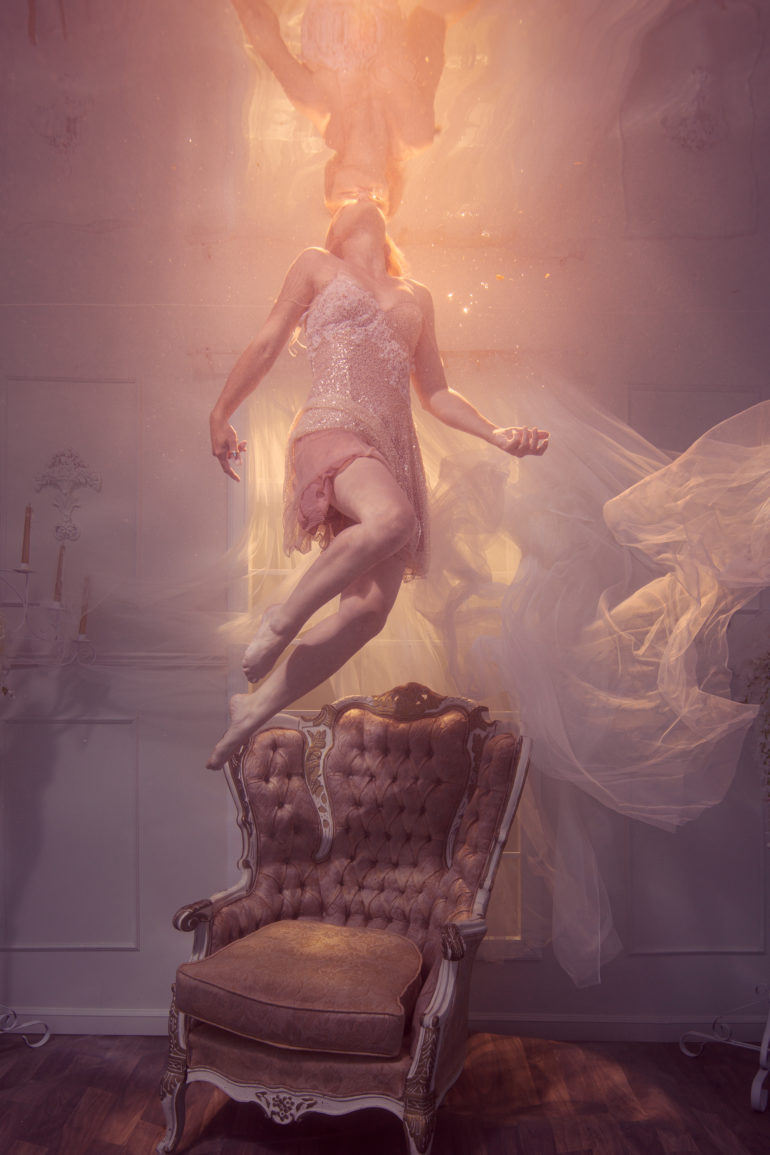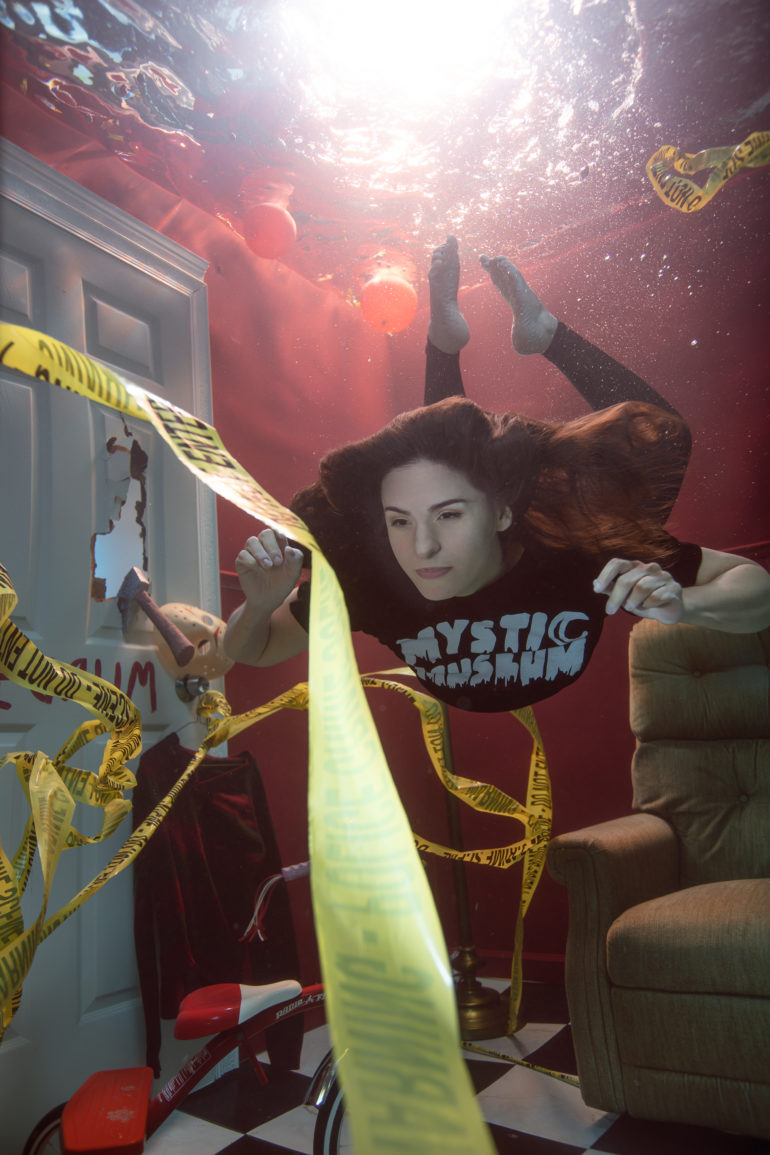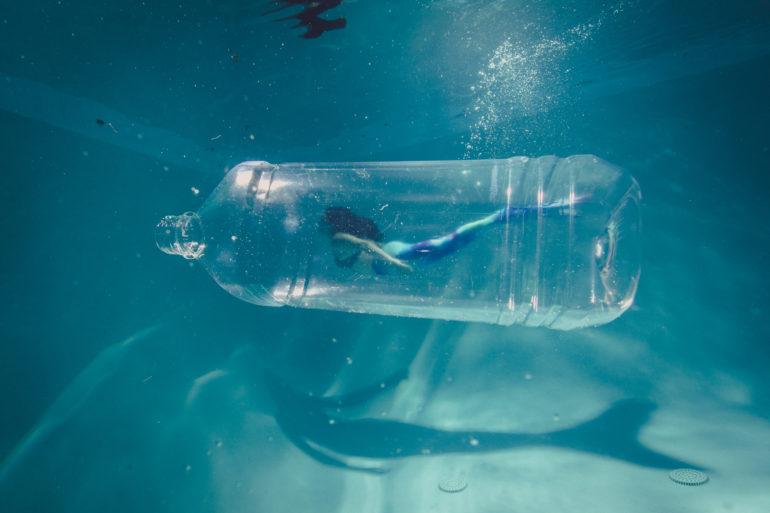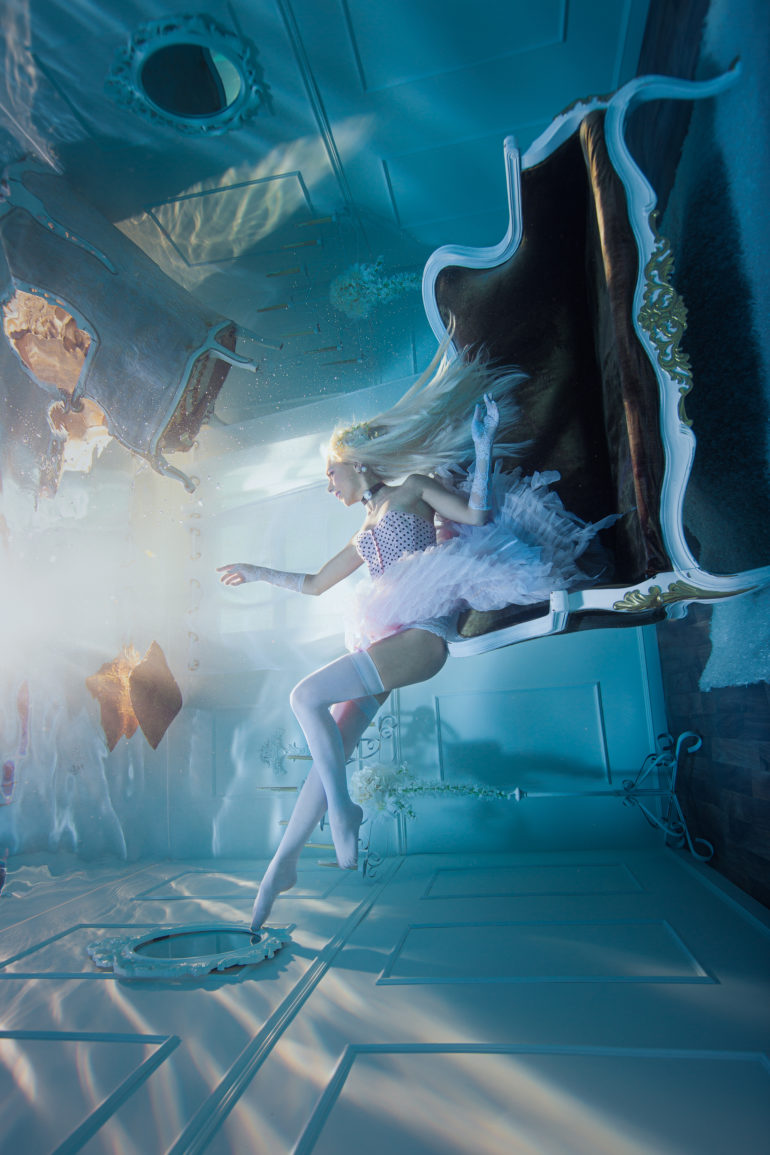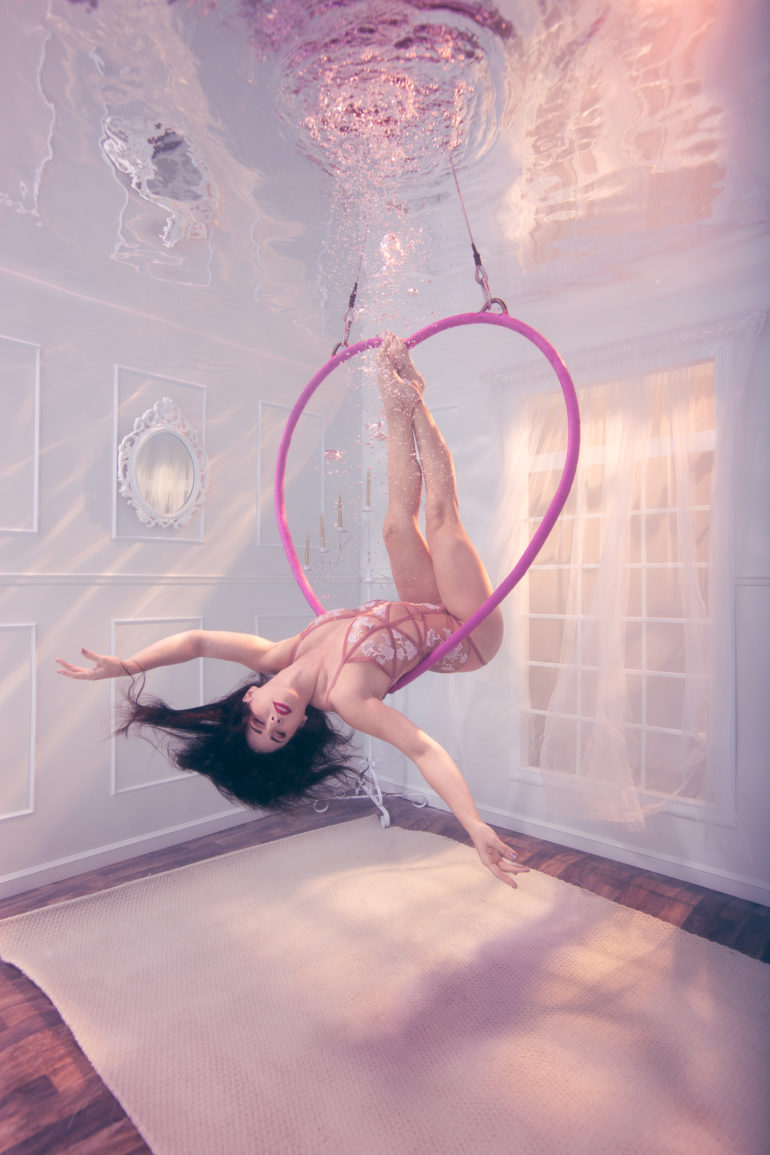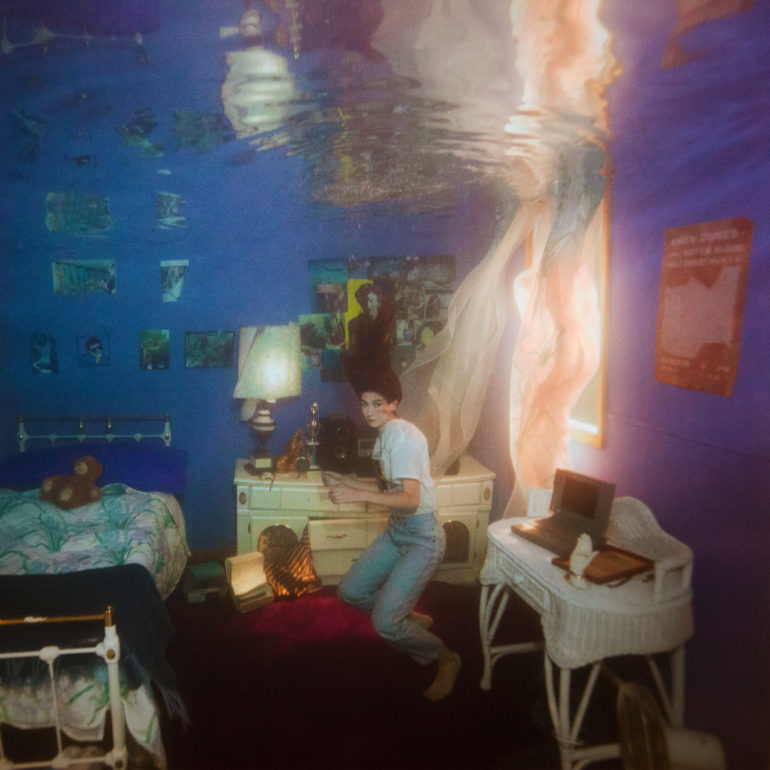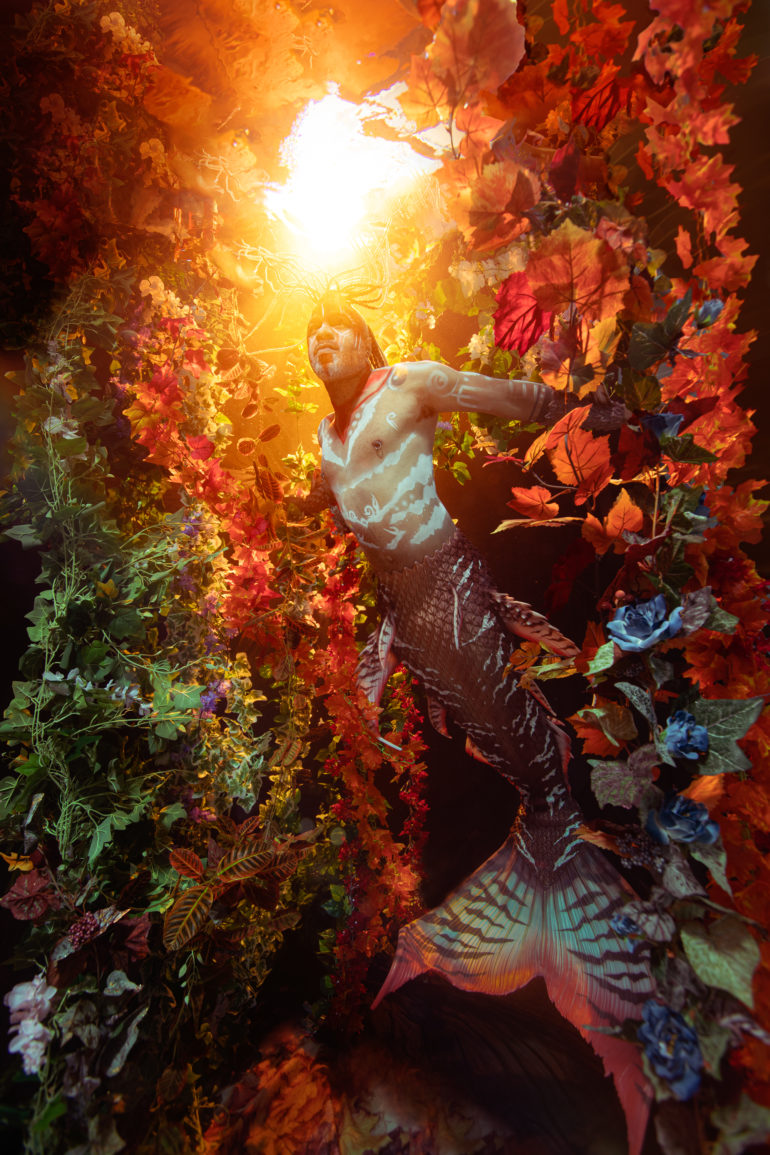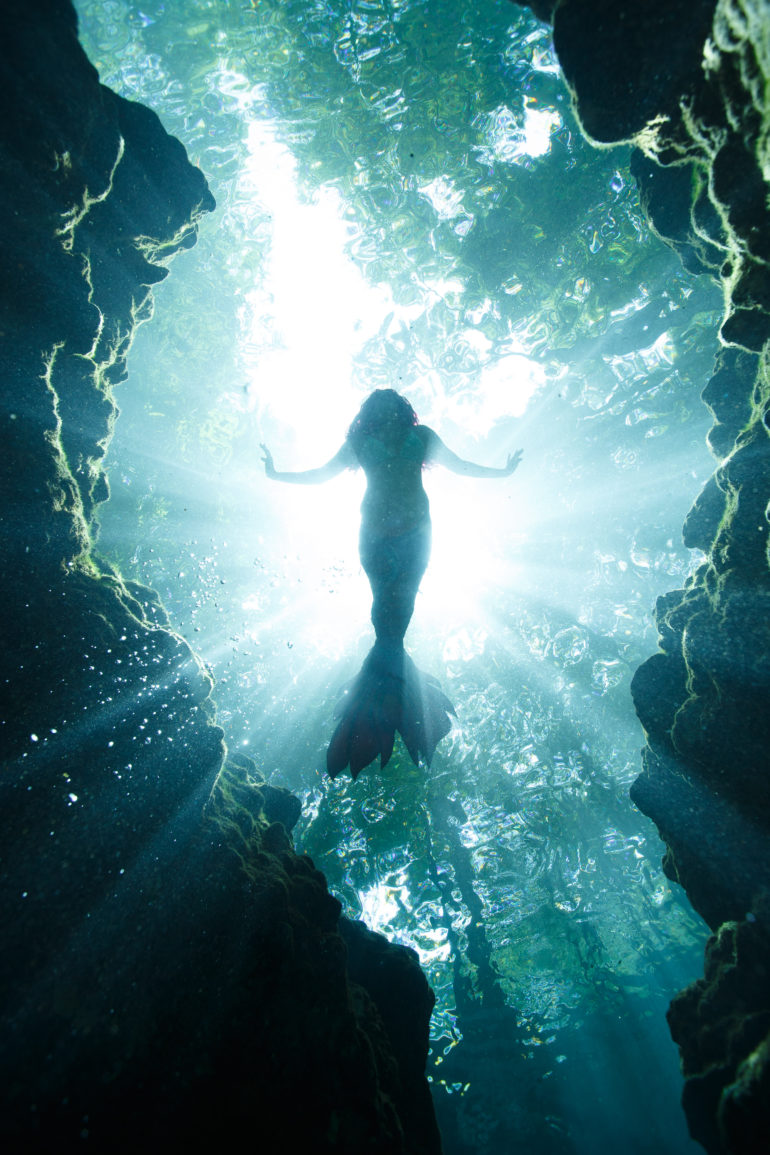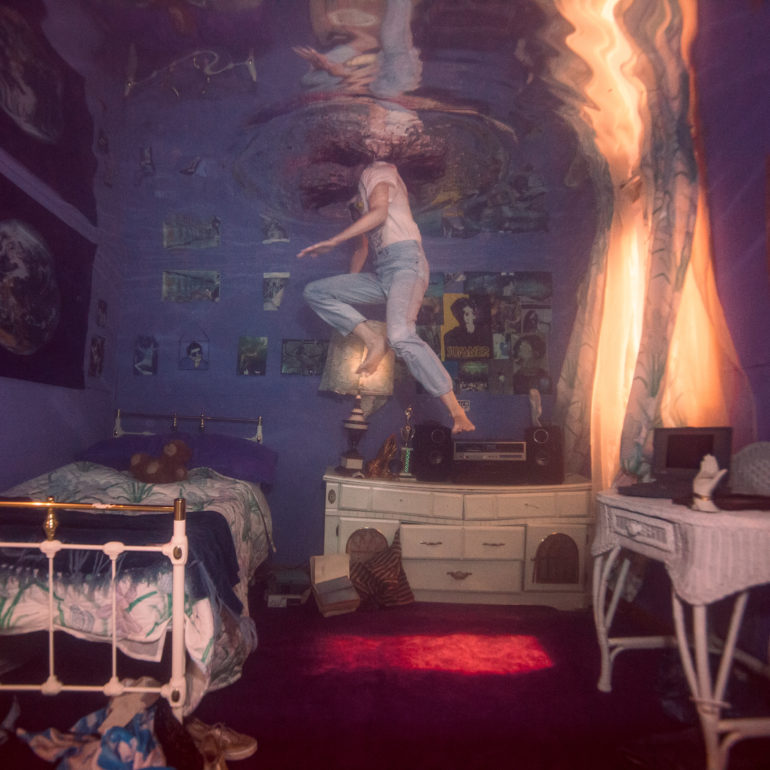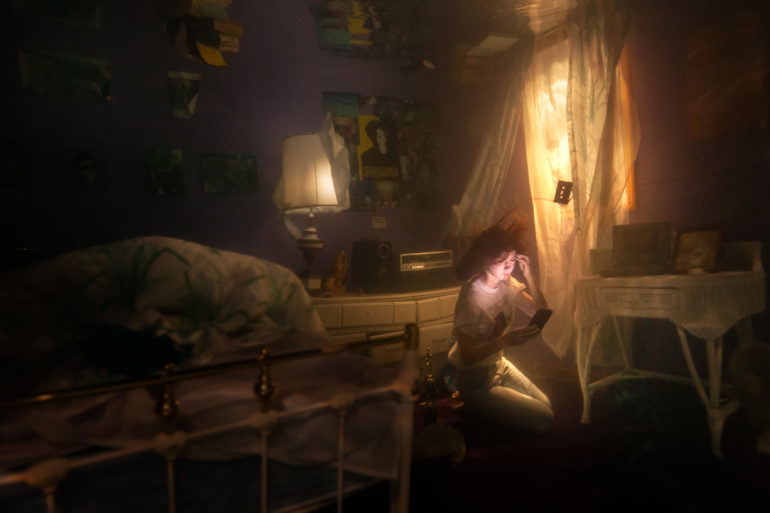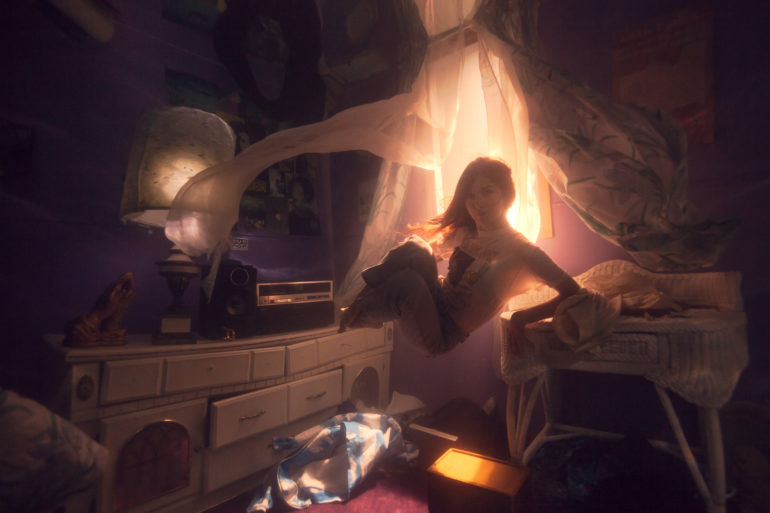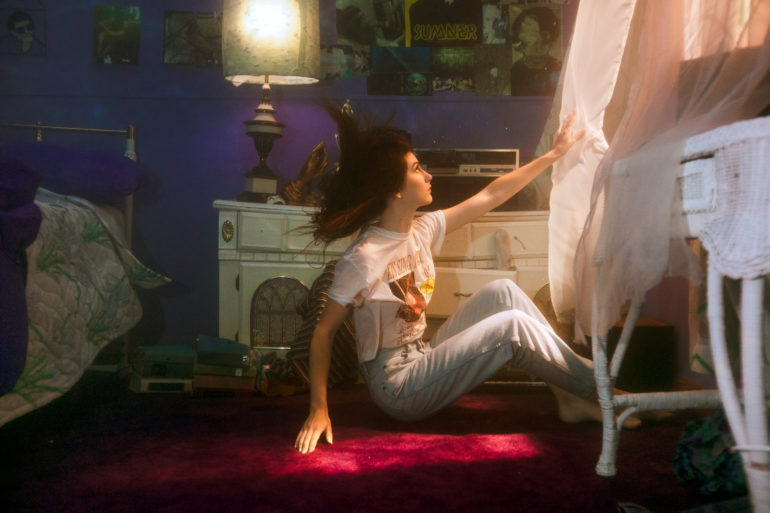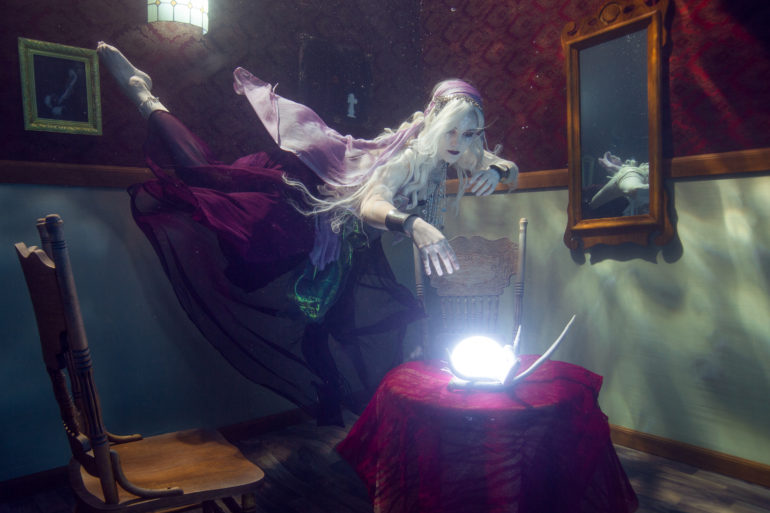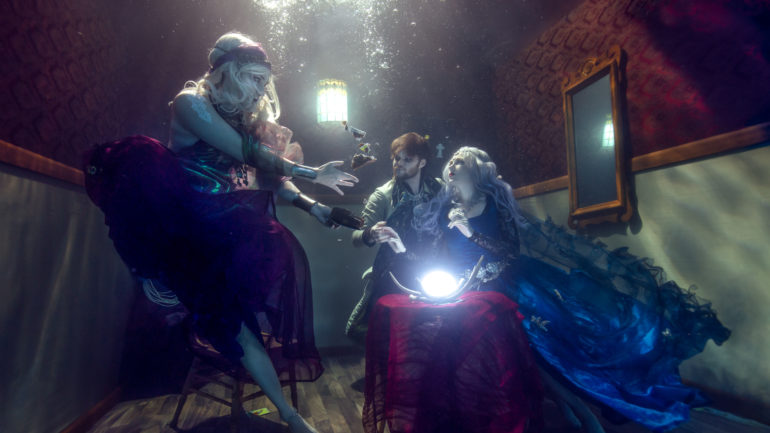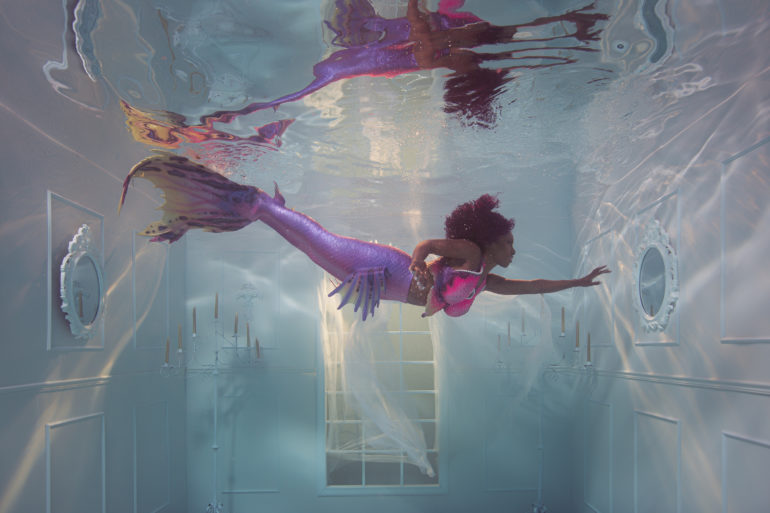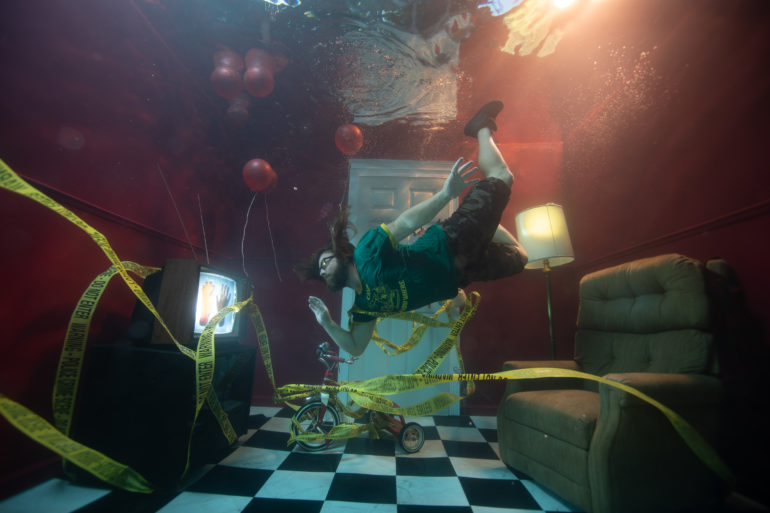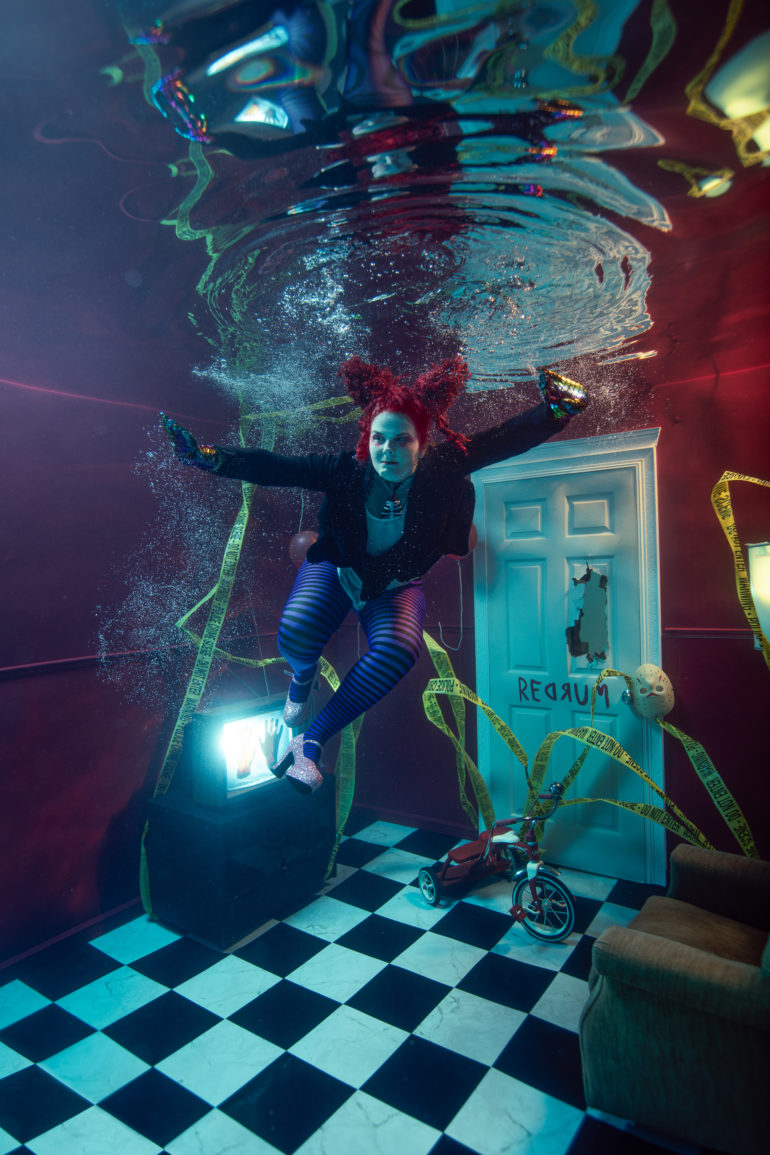“Props like couches are weighted down to make them sink, but they can be a pain in the ass – with one mattress needing almost 100 pounds before it started to sink,” says photographer Brett Stanley to us in an interview. “Most of the time I’m gutting furniture to remove all the foam and float stuff to make it easier – but they also tend to leach loads of dirt and color into the water as well, so by the time the set is dressed the water can be pretty murky.” Brett’s work was featured on our site before with his friend Christina Ren. And where most others might sit and composite all day, Brett works to build the sets himself for his surreal photos.
Brett’s work reminds us of masterful paintings. And that’s hitting the nail on the head because he’s partially inspired by them. He puts a big emphasis on color and how it’s affected by the water. But more than that, Brett also is very big on authenticity: something lacking a lot in modern photography. We adore how his photos carry a sense of elegance, mystery, and divine beauty. Surely, you stare at them thinking you’re looking at a dream. What’s more, You often want to look around the frame as Brett uses each and every part of it effectively. We talked with Brett about his images and how he makes the magic happen.
The Essential Photography Gear of Brett Stanley
My kit comprises my Canon 5dMK4 camera, 16-35mm 2.8 lens, Aquatica Housing with 8” dome, sea and sea ysd-2 underwater strobes, and Flashpoint AD600 Pro above water strobes with a variety of soft boxes.
The configuration of this gear is really important to me as it helps me shoot underwater in a studio style, which is really what I love lighting wise. I’m drawn to cinematic images where the lighting can be subtle but it’s also almost a subject the image itself.
Light works very differently as it passes through water, it refracts and bends, it loses intensity, and colours fade quite quickly – so the way each light source is directed and modified can change a scene quite dramatically. I’m addicted to the way light wan be shaped and the emotions it can bring for the viewer.
Camerwise I’m not too caught up in specs really, I just want a camera that takes a good balanced image, and since I’m shooting through water the quality of the lens isn’t really much of a concern to me as there’s already so much potential for distortion with just the water between me and the subject.
Phoblographer: Talk to us about how you got into photography.
Brett Stanley: I started in photography as a kid I think, with crappy 35mm Instamatic cameras for family holidays, but I didn’t really start to think about it creatively until I was in my late 20s. I love art, but I’m not good at drawing or painting so photography was my only real outlet. Once I started to learn more about depth of field and nice wide apertures I really found my footing and started to create images similar to other artists I admired. I build a dark room and learned how to create and manipulate film prints, which was just amazing – but so time-consuming, so when digital came in I jumped at it.
Phoblographer: What made you get into conceptual photography?
Brett Stanley: I think I love to create worlds or to create stories, I’m not really sure which – but I do know I love the idea of creating an image that the viewer can explore. Something that leads their imagination down random paths and lets them imagine a story behind it.
I’m also a huge fan of cinematography, so I think I really wanted to create images that looked like the scenes in movies that I loved.
Phoblographer: You are surely not a photographer who half-asses things. You go above and beyond using little to no Photoshop, building your own sets, and making things underwater too. Lots of photographers try to do this all in Photoshop. How do you feel about the idea of making your photos a whole productions vs just doing it all using CGI and stuff?
Brett Stanley: Ahhhh yes, this is such an important principle or dogma to me: if I can create the image in-camera then it will be much more rewarding than doing it in post-production. Not that I have anything against programs like Photoshop, I use them all the time and I love what others can do with compositing – but for me, I love the challenge of making something in the real world.
This wasn’t something that I always wanted to do, but since I got into shooting underwater I found that I wanted to actually BE in the worlds I was creating, rather than just shooting the elements that would end up together in the final image. So I started to build sets in my backyard swimming pool, and the feeling of swimming around a baroque ballroom or putting the sheets on a bed in a sunken ‘80s bedroom was Just. So. Cool!
So I kept building these sets and making them more intricate and more confusing to the viewer, as one of the benefits of shooting underwater is you get to mess with people’s minds by using the weightlessness and dreamstate of it all.
One thing I do, as part of my little dogma, is to make sure I’m doing these shoots underwater for a reason – and not just something I could have done on land with someone jumping in the air. There has to be a specific watery element to it all, like having the surface reflection in the shots, or bubbles. It needs to make use of the water, not just exploit it.
Phoblographer: Of course, there’s conceptual photography. But then you decided to do it all underwater. What’s your connection to underwater photography?
Brett Stanley: I’m obsessed with water! It’s my happy place, it’s what I dream about, it’s a space that brings creativity out of me like no other.
I grew up on the coast in Australia, we had a pool that I was in any chance I got – and I learned to scuba dive when I was 16. I feel like I belong when I’m underwater, but it also scares me. I have anxiety about water, and panic attacks, which is really confusing when that’s where my mind goes when I try to relax – but I love it so much that I have to overcome my fear every time just to I can get in the water and feel alive.
Phoblographer: Every creator tries to communicate something. What are you trying to express with your work?
Brett Stanley: You know, I really don’t have a plan when it comes to the meaning of my work. I think I’m just trying to get the visions that are in my head out into the real world. I’m also trying to share a place that I love with others, whether that’s with the viewers or with the subjects of my images – many of whom have never posed underwater before. It’s as much about the process as it is about the end result, and I love it when I have a new client who is changed and empowered by the photoshoot.
Phoblographer: One of the things blowing my mind about your work are all the lanterns, light bulbs, etc. How do you waterproof that kind of stuff?
Brett Stanley: Have I mentioned how much I love lighting? Being able to have a lit-up lamp or even a TV under the water is pure bliss to me. It took me a little while to work out how to do these kinds of practical effects, but honestly I generally just hide waterproof strobes and LED lights inside the lampshade – or in the case of the TV, a gutted television. I’m all about the practical effects.
Phoblographer: How does one even go about building a set underwater? Can I assume you’re draining a pool, securing everything down, and then flooding it? But then how do things like couches and beds stay in place?
Brett Stanley: Good question, and one I spent long sleepless nights figuring out.
The idea of draining the pool and building the set is valid but unfortunately way too much work and also very expensive to do – water isn’t cheap in Los Angeles. The way I do it is to build the set above the water, then break it down and rebuild it in the water-filled pool. The sets are made to come apart so they can be moved around and stored to be used again in the future.
Props like couches are weighted down to make them sink, but they can be a pain in the ass – with one mattress needing almost 100 pounds before it started to sink. Most of the time I’m gutting furniture to remove all the foam and float stuff to make it easier – but they also tend to leach loads of dirt and color into the water as well, so by the time the set is dressed the water can be pretty murky.
Phoblographer: Do you think your photos work in black and white, or do you feel like color is an essential part of your work? Why?
Brett Stanley: You know, I love black and white imagery but I can never seem to bring myself to convert any of my photos to monochrome. I just can’t let go of the colors! I think once I’ve seen the colored version I will always prefer it. I’ve toyed with the idea of just doing a shoot with the camera set to B&W, so I’m only in that headspace – I think that’s the only way I could produce monochrome images.
Phoblographer: Where are you drawing inspiration from these days?
Brett Stanley: So much of my inspiration comes from movies and tv shows, but also paintings and illustrations. I tend to look at others’ art and get inspired to try something underwater sparked by their creations – something unique that I’ve never seen done before. It’s hard, as there’s so many amazing artists out there, above and below the water.
Phoblographer: How has the pandemic affected you as a creative?
Brett Stanley: The pandemic put a huge pause to my creative output in 2020. I didn’t create a single image for about 8 months, but it gave me so much time to come up with ideas and to be inspired. It also gave me space to start a podcast, as everyone did, which led me to connect with so many amazing underwater artists and creators that I had no shortage of motivation and inspiration. It’s called, imaginatively, The Underwater Podcast and I get to interview some of the top underwater people creating some truly astonishing things.
I also created a magazine called Waterproof, which showcases the best in underwater art!
Be sure to follow Brett Stanley at his website, Instagram, the Undewater Podcast, and Waterproof Mag.


